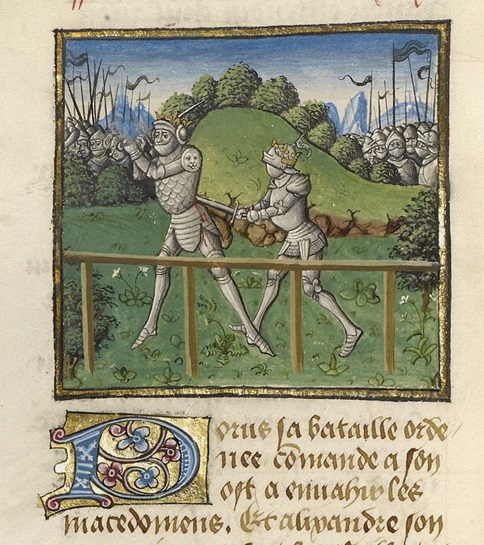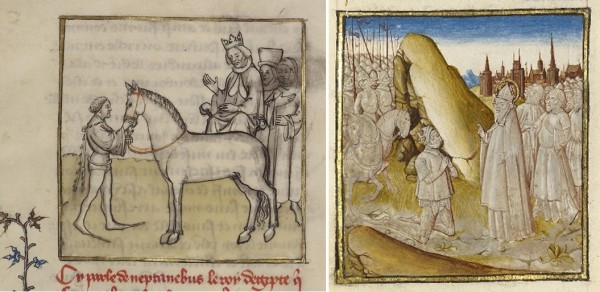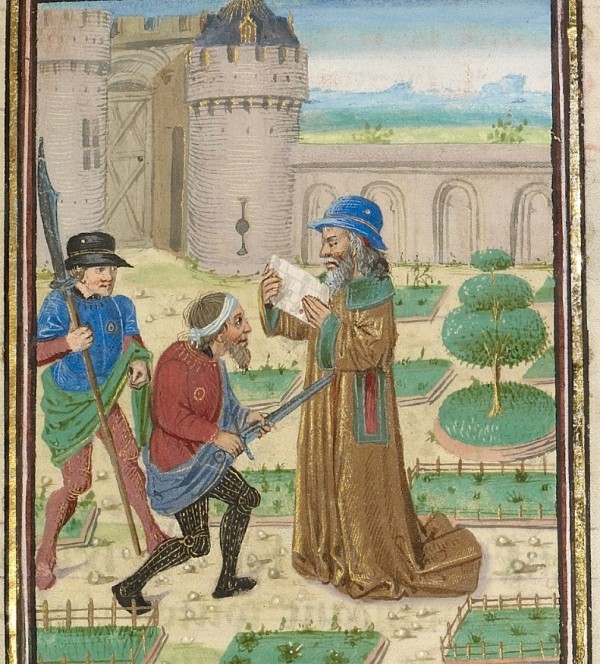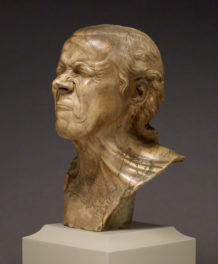
Initial P: Alexander the Great Carried Aloft by Griffins, about 1300, unknown artist, in the Historia Scholastica. The J. Paul Getty Museum, Ms. Ludwig XIII 1, fol. 222v; Alexander the Great in the Air (detail), about 1400–10, unknown artist, in the World Chronicle. The J. Paul Getty Museum, Ms. 33, fol. 221
Medieval artists, scribes, and translators made important choices about narrative, mood, historicity, and setting in their work—choices similar to those directors and screenwriters make today. This was especially true when adjusting a story to a new medium.
One of the most popular tales in the Middle Ages was that of Alexander the Great’s adventures and exploits. Drawn from a number of classical sources, Alexander stories were a blend of fact, romance, and Christianized history. Authors sometimes threw in a dash of the fantastic to add to the already-larger-than-life image of the ancient ruler, and artists often adapted the events to a medieval setting, using contemporary dress and architecture so viewers could relate to the tale. These changes—some subtle and some completely over the top—were accepted as part of the genre of history writing in the Middle Ages, where the lessons from the past were interpreted as guidance for the present and the future.
Changes made by writers and illuminators to the Alexander story as it evolved from oral history to text, and from text to image, have remarkable parallels to the changes made by screen writers when adapting a book—like one of our favorites, A Tale of Fire and Ice by George R.R. Martin (aka HBO’s Game of Thrones)—to today’s dominant visual medium, the glowing screen.

Alexander the Great and King Porus in Battle, about 1475, unknown artist, in Miroir Historial. The J. Paul Getty Museum, Ms. Ludwig XIII 5, v2, fol. 21v
The horrific image and terrifying screams of an innocent child burned alive still haunt the minds of Game of Thrones fans from the season 5 final episodes, as do numerous scenes of rape and violent murder added to the plot of the book series, which is drawn loosely from ancient, medieval, and early modern history. More and more the show has diverged from the plot of the books, but as author G.R.R. Martin acknowledged on his blog, “Prose and television have different strengths, different weaknesses, different requirements.” So, too, did text and illumination in the Middle Ages.

Alexander Fights in the Town of Sudracae (detail), about 1470–75, Master of the Jardin de vertueuse consolation and assistant, in The Book of the Deeds of Alexander the Great. The J. Paul Getty Museum, Ms. Ludwig XV 8, fol. 204
The Fascination with Alexander
Alexander the Great lived during the 4th century B.C. Few veritable texts survive from his lifetime, but his deeds and legacy were preserved first through oral tradition and later through written accounts. A handful of texts from the first centuries A.D. of the Roman period provided the most fodder for medieval authors.
Multiple artworks also capture Alexander’s portrait and deeds. The bronze pictured below is on view in the current exhibition Power and Pathos: Bronze Sculpture in the Hellenistic World.

Portrait of Alexander the Great, about 320 B.C., Greek. The J. Paul Getty Museum, 73.AA.27; Alexander the Great on Horseback, 100–1 B.C., bronze and silver. The Superintendency for the Archeological Heritage of Naples. Su concessione del Ministero dei Beni e delle Attività Culturali e del Turismo—Soprintendenza per i Beni Archeologici di Napoli. Foto Giorgio Albano
What sources do we have on Alexander’s life?
- Fragmentary eyewitness accounts survive, such as one by Alexander’s nephew Callisthenes of Olynthus about the conqueror’s campaign in Asia, and an influential text about the ruler’s legacy by Cleitarchus’s, a 3rd-century B.C. Greek resident of Alexandria.
- The most complete accounts of Alexander’s life come from Greek and Roman authors from the first and second centuries A.D., such as Plutarch, Arrian, and Quintus Curtius.
- Many medieval histories of Alexander’s life mixed fact and fantasy. Especially popular was the Alexander Romance, a collection of legends associated with the ruler that for a time were falsely attributed to his court historian, Callisthenes.

Alexander the Great with His Generals (detail), about 1360–70, Master of Jean de Mandeville, in the Bible Historiale. The J. Paul Getty Museum, Ms. 1, v2, fol. 138
Numerous manuscripts in the Getty’s collection recount and visualize the tale of Alexander the Great. In a fourteenth-century Historical Bible—the predominant medieval translation of the Bible into French—a scene of a dying Alexander opens the book of 1 Maccabees, which forms part of the Apocrypha between the Hebrew Bible and the New Testament. This type of manuscript contains portions of Peter Comestor’s Scholastic History, a kind of paraphrased Bible that also situates Alexander between the Old and New Testaments. The Getty owns a separate copy of Comestor’s work, in which we see Alexander carried heavenward by griffins (see the image at the top of this post), reflecting his desire to know all things and all realms of his dominion.
This same scene is included in Rudolf von Ems’s World Chronicle, a compendium of biblical and historical events. This particular chronicle also illustrates the famed tale of the diving bell, in which Alexander descends to the depths of the sea in a glass bell to explore the inhabitants of the sea floor. This event is one of the many obviously fantastical episodes from the famous Alexander Romance.

Alexander the Great Under Water (detail), about 1400–10, unknown artist, in the World Chronicle. The J. Paul Getty Museum, Ms. 33, fol. 220v
In the Middle Ages, the notion of history was more fluid than it is today. Two more manuscripts in the collection, for example, would have fit into the category of history in the Middle Ages, though today we might consider them literature or fantasy. Both draw their source material from the Roman 4th-century author Valerius and the Alexander Romance.
The History of the World until the Reign of Caesar recounts how Alexander tamed the monstrous horned lion-horse-man-eater Bucephalus, but the artist chose to depict the creature as a stallion ready for war; the pointy shoes, crown, and short tunic in the illumination are purely medieval. Vincent of Beauvais’s Mirror of History, a compendium of history through the year 1254, casts Alexander as a pious ruler who dismounts Buchephalus and kneels before the bishop of Jerusalem before making offerings to the god of Jews and Christians. An acceptable change for medieval Christian readers, but one that later humanists would criticize.

Alexander the Great, (detail), about 1390–1400 unknown artist, in History of the World until the Reign of Caesar. The J. Paul Getty Museum, Ms. Ludwig XIII 3, leaf 5; Alexander the Great with His Army before Jerusalem (detail), about 1475, unknown artist, in the Miroir Historial. The J. Paul Getty Museum, Ms. Ludwig XIII 5, v2, fol. 14
Embroidering History
One of the most influential medieval sources on Alexander the Great was the writings of Quintus Curtius, particularly as adapted into French by the great humanist translator Vasco da Lucena. Any gaps left by Curtius’s account were filled in with the writings of first-century Roman authors Justinus and Plutarch.
A Portuguese émigré to France, Vasco dedicated his translation of Quintus Curtius to Charles the Bold, Duke of Burgundy. The Book of the Deeds of Alexander the Great offers numerous stunning examples of how medieval texts differed from their historical sources, and how images deviated from the accompanying narrative. Images didn’t exist purely to illustrate the text. Instead, text and image worked together to weave a tale acceptable to the learned reader expecting moral guidance.
Vasco generally avoided embroidering history with fantasy. Not so the illuminator of the Getty’s copy of his work, who drew inspiration from a long history of illuminated volumes of the Alexander Romance. Buchephalus, for example, is depicted as a horned horse, despite the fact that Vasco flatly rejected the notion that Alexander’s famous steed was a supernatural being. We also find the Queen of the Amazons visiting Alexander in order to beget a child with him. Vasco includes the story, although most sources deny that this took place.
Curtius’s account of Alexender’s life includes many scenes of a traitor’s execution. One such death is described by Curtius as taking place by stoning, whereas according to Arrian it was by javelins. The artist of the Getty manuscript instead chose to depict decapitation (a familiar method of death for Game of Thrones fans). Later, after a drunken brawl in which Alexander mocks his father and kills one of his father’s generals (another scene fit for Game of Thrones), the hero fights and kills a lion. The text describes his weapon as a spear, but the artist creates a visual link with the mythical Greek hero Herakles by showing Alexander instead wielding a club.
 Perhaps the greatest change between the ancient sources and the medieval book concerns Alexander’s handsome eunuch-favorite-lover called Bagoas. In Vasco’s text, Bagoas is cast as a beautiful woman in order to “avoid a bad example,” as the author phrased it. Throughout the manuscript, Bagoas is shown in lavish garments and wears a turban to add an exotic, eastern allure. As we have seen, medieval authors and artists often made considerable changes to well-known and beloved stories. Readers and viewers understood these alterations as part of the process of history writing, or rather, of moralized and multiple-perspective histories.
Perhaps the greatest change between the ancient sources and the medieval book concerns Alexander’s handsome eunuch-favorite-lover called Bagoas. In Vasco’s text, Bagoas is cast as a beautiful woman in order to “avoid a bad example,” as the author phrased it. Throughout the manuscript, Bagoas is shown in lavish garments and wears a turban to add an exotic, eastern allure. As we have seen, medieval authors and artists often made considerable changes to well-known and beloved stories. Readers and viewers understood these alterations as part of the process of history writing, or rather, of moralized and multiple-perspective histories.

Orsines Presenting a Gift to Alexander and the Execution of Orsines (detail), about 1470–75, Master of the Jardin de vertueuse consolation and assistant in Livre des fais d’Alexandre le grant. The J. Paul Getty Museum, Ms. Ludwig XV 8, fol. 133v
Born with Dragon Blood (GoT SPOILER ALERT)
Stop reading if you haven’t yet watched the season 5 finale of Game of Thrones. And if you know nothing about the books or the series, you may be completely lost. You’ve been warned…
As megafans of Game of Thrones, we can’t resist teasing out a potential (and likely totally unintentional) parallel between Alexander the Great and Jon Snow, one of the book and show’s main protagonists, who appeared to meet a tragic end in the season 5 finale.

The Birth of Alexander (detail), about 1470–75, Master of the Jardin de vertueuse consolation and assistant, in Livre des fais d’Alexandre le grant. The J. Paul Getty Museum, Ms. Ludwig XV 8, fol. 15
One of the most fantastic episodes from Alexander the Great’s legendary life is his extraordinary birth, which is recounted in numerous ancient and medieval versions. In the Getty’s copy of the Book of the Deeds of Alexander the Great, Olympias holds the newborn Alexander while a dragon descends upon her bed from the upper-left-hand corner. Quintus Curtius wrote that Philip of Macedon dreamed of a dragon sleeping next to his wife, which the Delphic Oracle interpreted as the god Zeus Amnon. Plutarch, however, claimed that Philip’s dream indicated that Olympias was performing Bacchic rituals with snakes. Still later, the Alexander Romance maintained that the dragon was actually Nectanebo, the last king of Egypt and possessor of godlike powers, in disguise. The identity of Alexander’s father, which seems decided today as Philip of Macedon, was actually quite deliberated upon in the past.

Courtesy of HBO
Currently, the parentage of another beloved (albeit fictional) character is also the topic of heated debate: Jon Snow’s parents remain a mystery to fans of G.R.R. Martin’s series A Song of Ice and Fire and HBO’s show Game of Thrones.
Jon Snow is repeatedly dubbed “Ned Stark’s bastard,” a reference to a supposed misstep by the once-warden of the north. Until recently, discussion about this supposed father-son relationship has centered on the question of maternity. Some fans claim that Jon Snow’s mother was merely a wet nurse with whom Ned Stark had a dalliance, while others are adamant that she was Ashara Dayne of the southern kingdom of Dorn, a woman whom Ned loved before his marriage to Caitlyn Tully of the riverlands.
However, an alternate theory exists: that Ned Stark is not Jon Snow’s father, and that Jon is actually a Targaryen. Popularly known as “R+L=J” (Rheagar Targaryen + Lyanna Stark = Jon Snow), the theory claims that Lyanna Stark (Ned’s younger sister) and Rheagar Targaryen (crown prince to the throne) fell in love, eloped, and had a child. The theory maintains that Lyanna, on her death bed, begged her brother Ned to protect her newborn son, which he does by claiming his nephew as his illegitimate son.
Jon Snow’s situation not only mirrors Alexander’s with the conflicting theories about their paternity, but also in the claim that they could possibly be descended from royal and more-than-mortal figures. While Jon’s possible fathers do not quite compare to Zeus, the king of the gods himself, the House Targaryean does boast an amazing connection to and descent from dragons, which is certainly nothing to scoff at. Thus Alexander and Jon may have both descended from dragon-blood.
Alexander and Jon Snow share more than just questions about their family tree. Both warriors raised fearsome pets that accompanied them into battle. Jon’s direwolf, Ghost, always proves himself useful in combat, and Alexander’s horse Bucephalus was thought to be a hybrid horse-monster that would devour those who stood against his master. Additionally, Alexander faced betrayal amidst his ranks, managing to thwart assassination plots involving even some of his closest generals, like Alexander of Lyncestis, Sisinnes, and Parmenion (shown below being assassinated in a garden due to his acts of treason). As the Game of Thrones season finale revealed, Jon Snow was not so fortunate in his dealings with traitors, as he was quite literally stabbed in the back by his comrades and left for dead.

The Death of Parmenion (detail), about 1470–75, Master of the Jardin de vertueuse consolation and assistant, in The Book of the Deeds of Alexander the Great. The J. Paul Getty Museum, Ms. Ludwig XV 8, fol. 154
Now that the television series has inevitably caught up to the books, there is no telling what will happen next or how far the two media will continue to diverge. But A Song of Ice and Fire is not the first popular story to be altered and adapted to fit into a new historical context or a different medium. Just as the creative license used by the writers and artists in the Middle Ages turned the life of Alexander the Great into a multitude of different stories, so too the writers of Game of Thrones have begun to create storylines independent from the books. Although this thought rankles a bit, perhaps for the sake of sanity fans must follow Martin’s advice, and the example of the Alexander legends, and think of the book and the show as separate entities.

Alexander the Great Consulting the Prophetic Trees of the Sun and the Moon, about 1400–10, unknown artist, in the World Chronicle. The J. Paul Getty Museum, Ms. 33, fol. 221v (detail)




Comments on this post are now closed.